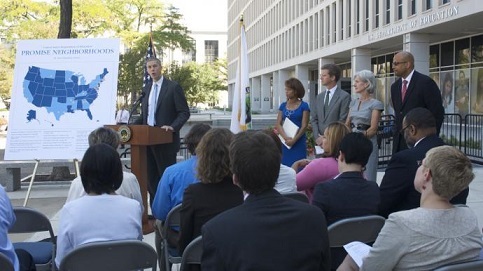
Harvard’s Innovations in American Government Awards

Assistant Deputy Secretary Jim Shelton after announcing the $28 million Promise Neighborhoods grant for the Northside Achievement Zone at Elizabeth Hall International Elementary School in Minneapolis on Dec. 19. Image courtesy of Bre McGee for the U.S. Department of Education.
The Neighborhood Revitalization Initiative (NRI) and HUD’s Sustainable Communities Initiative (SCI) were recently honored as two of the Top 25 Innovations in American Government by the Ash Center for Democratic Governance and Innovation at Harvard’s Kennedy School of Government. The awards highlight exemplary models of government innovation that advance efforts to address the nation's most pressing concerns.
Both NRI and SCI have changed the way the federal government invests in communities, through a comprehensive, multidimensional approach to revitalizing communities and spurring economic development rather than a siloed approach. The connections among housing and educational opportunities, or economic development and transportation infrastructure, for example, are not reflected in the structure of Cabinet agencies or Congressional committees. Separate grant programs across agencies were not coordinated, making it difficult for local leaders to address community challenges comprehensively.
Rather than focusing singularly on building affordable housing, improving services for children and youth, addressing crime, or developing transportation infrastructure, NRI and SCI connect these investments across federal agencies.
Neighborhood Revitalization Initiative
NRI brings together five federal agencies – the Departments of Education, Health and Human Services, Housing and Urban Development, Justice, and Treasury – to coordinate investments in housing revitalization, educational opportunities, crime prevention, economic development, and access to healthcare. Past federal efforts that focused singularly on transforming housing, reducing crime, or stimulating economic development failed to recognize the cause-and-effect cycle among these challenges.

Secretary of Education Arne Duncan, joined by Melody Barnes, the director
of the White House Domestic Policy Council, Secretary of Housing and Urban
Development Shaun Donovan, and Secretary of Health and Human Services
Kathleen Sebelius, announces the first Promise Neighborhoods planning
grants.
"It was the reason why so many [revitalization] efforts failed," explained Angela Blanchard, chief executive officer of the Houston-based nonprofit Neighborhood Centers, Inc. "They only wanted to fix one dimension. So the school would be wonderful, but the housing would be terrible. Or the housing would be great, but there was no [health] clinic."
NRI aligns existing federal programs, such as Choice Neighborhoods, which builds on the successes of HOPE VI in transforming public and assisted housing, Promise Neighborhoods, modeled on the cradle-to career pipeline of services for children and youth pioneered by the Harlem Children’s Zone, and Byrne Criminal Justice Innovation, which funds evidence-based strategies for targeting and reducing crime hot-spots. Together, these programs have invested $350 million in more than 100 communities since NRI was launched in 2010.
By targeting federal funds across agencies in a single neighborhood, rather than across a city, NRI aims to provide local leaders sufficient funding to effectively address persistent poverty and sustain revitalization efforts over the long term.
Sustainable Communities Initiative
HUD’s SCI was created to help build strong and resilient communities through a more integrated planning process that connects housing and transportation options to job centers. Over the past half-century, the distance between job centers and housing has grown, forcing the average household to spend a significant portion of its budget on housing and transportation costs. Many neighborhoods are still marginalized—affordable housing, transportation choices, and basic amenities like grocery stores are scarce in underserved communities.
To address these challenges, SCI designed two pioneering grant programs. Regional Planning grants support the development of regional blueprints that link investments in transportation, housing, and the environment, catalyzing strong regional economies. Community Challenge grants support community efforts to modernize local policies and codes to achieve inclusive, economically viable development. These grants can result in cost-savings for both households and cities. In the Chicago metropolitan area, and SCI Regional Planning grant is supporting a project that is expected to reduce new local street miles by one-third. Road maintenance savings alone will total approximately $1.5 billion.
To ensure its grants are coordinated with other federal investments, in 2009, HUD joined forces with the Department of Transportation (DOT) and the Environmental Protection Agency (EPA) to form the Partnership for Sustainable Communities. Through this collaboration, these agencies have invested close to $4 billion in 700 communities.
Both NRI and SCI are delivering lessons that will shape federal policies such as the recently announced Promise Zones initiative, which brings together key elements of evidence-based federal programs to drive revitalization and economic recovery in 20 distressed communities.
PD&R Leadership Message Archive
International & Philanthropic Spotlight Archive
Spotlight on PD&R Data Archive
Publications
Collecting, Analyzing, and Publicizing Data on Housing Turnover
Resilience Planning: What Communities Can Do to Keep Hazards from Turning into Disasters
Cityscape: Volume 26, Number 3
Case Studies
Case Study: Former School in Charleston, South Carolina, Transformed into Affordable Housing for Seniors
Case Study: Avalon Villas Combines Affordable Housing and Services for Families in a Gentrifying Phoenix Neighborhood

The contents of this article are the views of the author(s) and do not necessarily reflect the views or policies of the U.S. Department of Housing and Urban Development or the U.S. Government.
Note: Guidance documents, except when based on statutory or regulatory authority or law, do not have the force and effect of law and are not meant to bind the public in any way. Guidance documents are intended only to provide clarity to the public regarding existing requirements under the law or agency policies.



